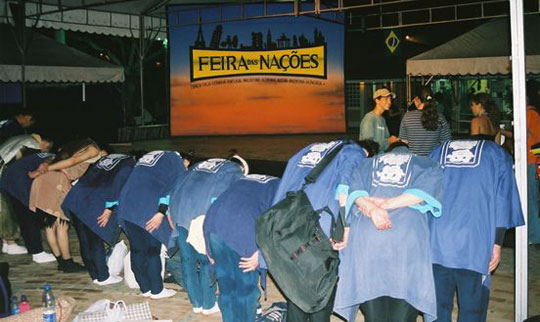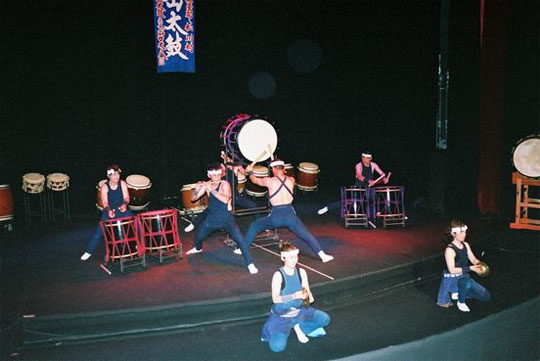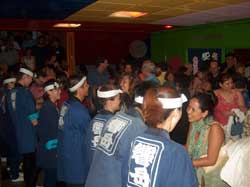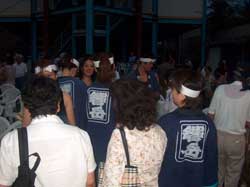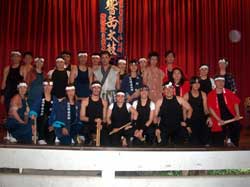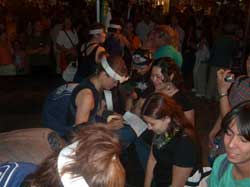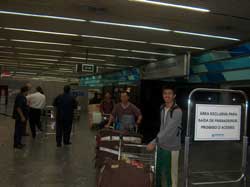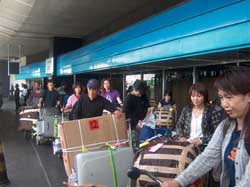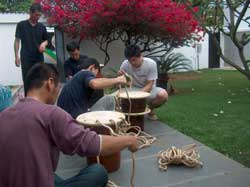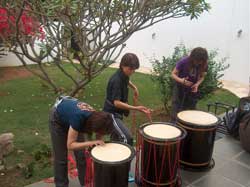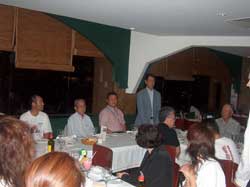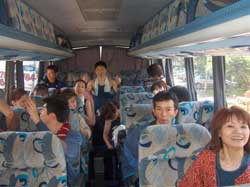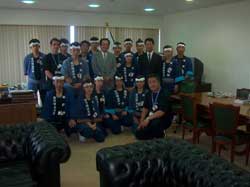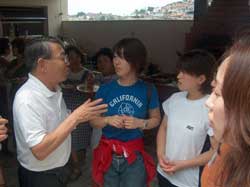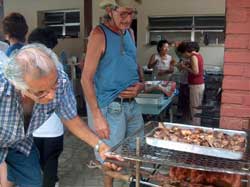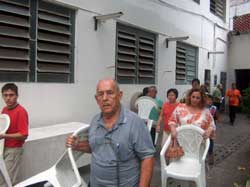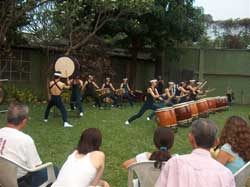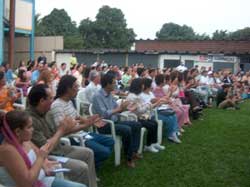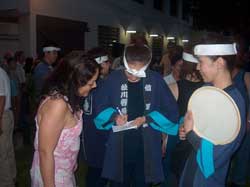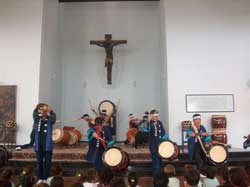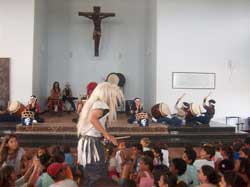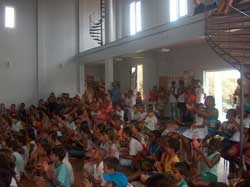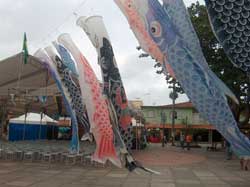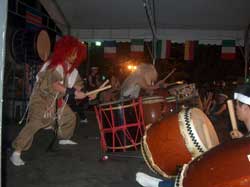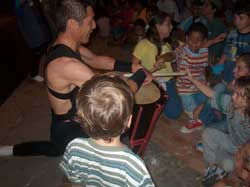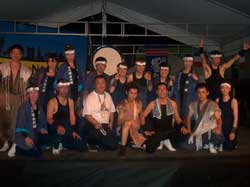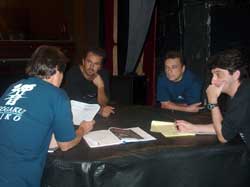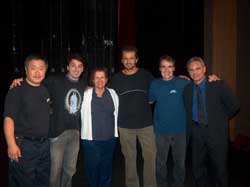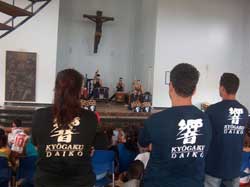Written by
Gaku Homma
Nippon Kan Kancho
The audience was on their feet. The clapping and cheering was thunderous, the stars above the town square seemed to tremble with the whistling and the shouts of encore, encore! On stage the drummers stood in a row facing the audience heads bowed deeply. They raised their heads in unison, all eyes glistening as they waved to the audience before them. Some of the drummers did not hide the tears of joy that rolled down their faces as they listened to the cheering crowds. It was a moment of triumph. It had taken seven long month of serious practice to prepare for this concert event…
This was the last concert of the Matsukawa Kyogaku Taiko Drummers World Tour 2005, held in the central square of the popular resort town of Buzios, two hours to the coast outside of Rio de Janeiro, Brazil. Over 700 locals and tourists from countries far and wide had gathered for this last performance, and the audience had responded in kind to the powerful energy the drummers put forth for this crowning event.
The crowds had been wonderful for the first concert of the tour, held at a local theater in Copacabana Beach, as well as the performances for the Japanese Brazilian community, and the Moacir Bastos College, but the crowds were the wildest on that last night in Buzios.
- Greeting fans at the Baden Powell Theater.
- The crowds at the Moacir Bastos College
- With the Rio Nikkei Taiko drummers.
- More fans in Buzios.
Every one was thrilled with the beat of the drums.
The sixteen drummers had come from Japan to Rio de Janeiro to perform a series of concerts as part of an awareness campaign for AHAN Rio de Janeiro’s (Aikido Humanitarian Active Network) humanitarian and cultural activities. This project was coordinated by Nippon Kan AHAN General Headquarters in Denver, Colorado and AHAN Rio de Janerio in Brazil.
Transporting sixteen drummers, costumes, drums, and other equipment from Japan to Brazil plus providing lodging, meals and transportation in Brazil was a big financial undertaking. The drummers, world class performers in high demand in Japan and other parts of the world, raised a large part of the financial support needed for this venture themselves. The drummers saved proceeds from local concerts and obtained funding through local government grants, but primarily provided for the expenses associated with this humanitarian project themselves.
This venture was not only a financial challenge for the drummers, but presented other challenges as well. Most of the drummers are married with families and have jobs and businesses of their own that had to be cared for during their absence. Before the concert tour, months of special practices were held in preparation for this trip, which meant that time was sacrificed from families, coworkers and supervisors who lent their support to this project with their patience and the extra work they took on. Without the support of the entire village, this project could never have become a reality. To all of the people behind the scenes back home in Matsukawa village, I give my sincere thanks in recognition of their contributions.
On the receiving side, our hosts in Rio de Janeiro, the Nippon Kan AHAN Rio staff worked incredibly hard organizing all of the events. The Consul General of Japan at Rio and his staff worked to help with customs and visa requirements for the drummer’s entry into Brazil, and the Nippon Kan AHAN General Headquarters in Denver staff worked diligently on scheduling and facilitating communication. This project was unique in the fact that it took a coordinated effort from staff members in three different countries, thousands of miles apart to make this dream come true.
- Arriving in Rio.
- Trying to get over jetlag.
- Taking care of the drums comes first.
- Checking the drums.
- Katsugi Taiko checked by the women drummers.
- Welcome Party with the Deputy Consul General Ikeda.
- The tour begins!
- Drummers with Consul General Kamitani.
It took the drummers almost two full days to fly from Japan to Rio de Janeiro. Only minutes after they landed it seemed the work began; five concerts in four locations to be performed in the six days to come. The beat of the drums set the pace as the teamwork began. A power from within kept the drummers moving through the rigorous schedule in a heat and humidity the drummers had never known. The concerts were not meek, antiseptic cultural demonstrations; they were gifts of power and beauty from the inner hearts and souls of the drummers given with joy enthusiasm to the people of Brazil.
A special part of this trip was the meeting between the drummers of Matsukawa and twenty seven Japanese-Brazilian pioneer settlers who traveled by bus throughout the night from Sao Paulo to attend one of concerts. These twenty seven settlers had come to Brazil many decades ago from the same village of Matsukawa, and the meeting between these two generations was a moment that will stay with me forever.
The now elderly Japanese Brazilian settlers and the drummers of the same village in Japan met each other in a standing cheer of Bonsai! Together they sang the songs of the village, and there were tears visible on both sides of the aisle. The years of hard work showed in the lined faces and calloused hands of the elder Japanese pioneers who had labored away their youth carving out a new existence in this foreign land. They asked about the welfare of family and friends back home, yet many of the drummers were too young to have known those of that generation left behind.
More than the success of all the scheduled concerts, this exchange and the happiness that was visible in the eyes of the elder Japanese pioneers was something I will not soon forget.
- Singing songs from the homeland.
- Asking about folks back home.
- and more singing…
- Famous Brazilian dish CHURRASCARIA.
One of the goals of Nippon Kan AHAN General Headquarters and the Matsukawa Kyogaku drummers was to bring Matsukawa drumming to all of the people of Brazil, but it was also important to make a special point to honor the Japanese Brazilian community with this music from their homeland. Tour Coordinator and AHAN Founder Gaku Homma Kancho discussed with the drummers before their arrival in Brazil the importance of meeting this generation from Matsukawa as a way to honor their efforts so far from home.
The Nikkei Kaikan (Japanese Brazilian Center) concert was the setting for this concert for the Japanese Brazilian community. Here the drummers from Matsukawa were joined by the Rio Nikkei Taiko (Rio Japanese Brazilian Drummers). ALL of the drummers together made wonderful Japanese music that was thoroughly enjoyed by the Nikkei in attendance. As this was a goal of this tour, it was a wonderful sight to see.
- Drummer’s leader Mr. Chino coaching the local Nikkei Taiko
- Finale with Rio Nikkei Taiko.
The next challenge we soon discovered was the weather. It had started to cloud up and definitely looked like rain. The crowds had already started to line up however so the leader of the drummers, Mr. Chino thought for a moment before deciding to perform outside in the wake of a looming storm. This was a risky decision, as the drums are covered with specially made hides that could be ruined if soaked in the rain. As I watched the drummer’s leader, Mr. Chino make decisions about the performance, my respect for him grew.The next stop was Moacir Bastos College, two hours by bus from Rio de Janeiro. The college administrators greatly underestimated the power of the drummers, and it soon became apparent that the acoustics in the gymnasium they had chosen for the location of the concert would not be at all adequate. It was quickly decided to move the concert to an outdoor area where the drummers could perform in a better acoustical environment.
After the decision to move the performance was made, even the audience lent a hand, grabbing chairs and moving them from the gymnasium to the outside arena. I felt like I had caught a true glimpse of the heart of these Brazilian people as I watched them line up the chairs in place.
To the delight of the audience, the drummers performed for an hour and a half between occasional sprinkles and an ever-present threat of a downpour. The performance was outstanding, and that left everyone cheering for more.
- Planning meeting before the show
- Members of the audience carrying chairs
- The drummers deliver at the outside location.
- The audience picks up the beat.
- Photo souvenirs.
- Giving autographs.
The concert was to be held at the church adjacent to the schoolyard. The drummers as it turned out were to have an experience performing here that they had never had in the entire history of the Matsukawa drummers. High behind the stage where the drummers were to perform hung a very, very large statue of Jesus on the Cross. Where the drummers set up to play, Jesus looked down on them, larger than life, larger than all of the drummers put together. It was a little intimidating for the drummers at first, but actually the drum in Japan has it’s origin in Shinto religious ceremonies, so although a little different for them, the drummers played for the first time under the watchful eye of Jesus and 350 Brazilian children.Another two hour bus ride to the coast lays the city of Buzios, a popular resort for tourists from Europe and other parts of the Americas. Our first stop in Buzios was an elementary school where the drummers were scheduled to play for about 350 school children.
- First experience playing for Jesus.
- For the children, this was a very new experience.
The concert was phenomenal, as described…at the beginning of this prose.Later that evening, it was time to set up for the last concert of the tour. The concert was to be held at the Buzios town square, and as the drummers prepared for this final event, over 700 tourists and locals filled the square, ready for the show to begin.
When the audience had finally filed from the square after the show, the drummers came down from the stage. They lined up together in a single line facing the stage and their drums still set in place before them. The drummers bowed low in unison to the stage, their drums and to the stars above. It was an offering of thanks and respect from the drummers to the over 2000 Brazilian people who had heard their music over the last days, and to all of the people and all of the effort it had taken to make this dream come true.
The following day we spent time walking through town, shopping and seeing the sites. Locals and tourists alike stopped the drummers on the street to thank them for such a wonderful performance. The drummers had given their all at the concert the night before, and this show of recognition and appreciation was humbling reward. For this day, the drummers were celebrities in the city of Buzios on the bay.
- Raising the carp (koi) kite for the show.
- The innocence of children.
- The peak of concert.
- Drummers leave the stage to play.
There are other Japanese Taiko drumming troupes that travel the world to perform. Most are accompanied by technical crews, managers, publicists and promoters. The Matsukawa Kyogaku Drummers, worldclass in their own right, are performers with a sense of heart and community that is rare. We say in Japan, “they carry their own lunch box”, which means that they do not only work for money, but have the power and the spirit and the foresight to support humanitarian and cross-cultural projects such as this around the world.The Matsukawa Kyogaku Taiko Drummers have played many times in countries other than Japan. This Brazilian concert series was the second international tour coordinated by Nippon Kan AHAN Headquarters in Denver. Last year, the drummers visited Denver, Colorado, to assist in an AHAN humanitarian support campaign to send refurbished computers to Mongolia. With the drummers help, AHAN has provided sixty computers to schools, monasteries and humanitarian organizations in Mongolia, and the projected goal for 2005 is 100 computers to those in need.
On this trip, over 2000 Brazilian people were touched by the power of the Matsukawa drummers’ music, but to truly appreciate the talents of this accomplished and professional group, it is important to remember their generosity and heart. It is also important to acknowledge the support of the village of Matsukawa, all of the family members and friends and townspeople that allowed the drummers to reach this goal through their support.
- We can’t forget all the efforts of the AHAN Rio staff.
- With the lighting crew
The sound of your drums reverberates into the future of Nippon Kan AHAN projects in Brazil and around the world.I sincerely thank the sixteen drummers from Matsukawa for all of the hard work you put into promoting awareness for AHAN Rio de Janeiro and your efforts to support orphanages and other community services in Brazil. Your drums provided inspiration, a sense of accomplishment and a renewed strength of purpose and direction for all AHAN Rio staff and supporters.
In closing I would like to thank everyone individually for their help and support in this project:
Brazil
Deputy Consul General of Japan at Rio de Janeiro, Mr. Toshio Ikeda
Consul General of Japan staff member, Mr. Naohiro Yoshida
Nippon Kan AHAN Rio President Luc Leoni
Nippon Kan AHAN Rio Staff Legal Representative Marcio Luiz Guerra Fontes
AHAN Rio Staff:
Alvaro Carvalhaes
Luciana Rodrigues Viera
Deliane Ramiro Coelho
All AHAN Rio Members
Baden Powel Theater staff
Moacir Bastos College staff
City of Buzios Administration staff
City of Buzios, Department of Education staff
Rio Nikkei Taiko Drummers
Rio Nikkei Association staff
All Aikido Nippon Kan Brazil members and friends
and, the fine people of Brazil. Japan
Matsukawa Kyogaku Taiko leader, Mr. Eitaro Chino
Matsukawa Kyogaku Taiko drummers:
Takashi Katsuie
Shigeru Shirasawa
Tatsuya Nakagawa
Yuko Yamamoto
Risa Okuhara
Shigeru Yokoyama
Tatsuya Okada
Emiko Tozawa
Yuriko Nakamura
Yoko Agata
Kenji Fukasawa
Miyuki Fukai
Yukika Matsuda
Chie Ueda
Nobuhiko Takahashi
Nippon Kan AHAN Japan branch coordinator, Yutaka Kikuchi
United States
Nippon Kan General Headquarters’ Kancho, Gaku Homma
Nippon Kan AHAN General Headquarters’ President, Emily Busch


